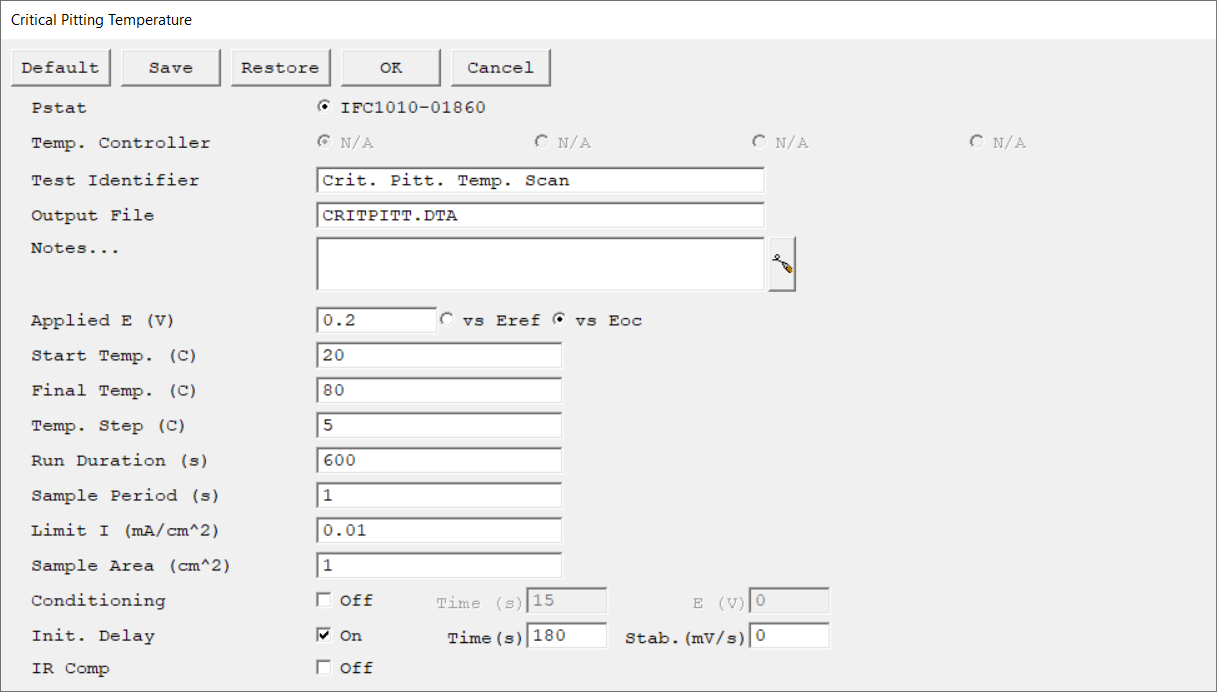Description
Parameter |
Description |
Units |
||
|---|---|---|---|---|
Select the potentiostat/galvanostat to perform the experiment. Each radio button corresponds to an installed potentiostat. You can select only one potentiostat at a time. Potentiostats that are already in use are marked with an asterisk. They can be selected but cannot be used. |
|
|||
Select the temperature controller for the experiment. Most Critical Pitting Temperature (CPT) systems have only one temperature controller, so this parameter may not be required. However, you may install support for more than one type of controller. |
|
|||
A string that is used as a name. It is written to the data file, so it can be used to identify the data in database or data manipulation programs. The Identifier string defaults to a name derived from the technique's name. While this makes an acceptable curve label, it does not generate a unique descriptive label for a data set. The Identifier string is limited to 80 characters. It can include almost any normally printable character. Numbers, upper- and lower-case letters, and the most common punctuation characters including spaces are valid. |
|
|||
The name of the file in which the output data are written. By default, it is saved in the default file directory.
|
|
|||
Enter several lines of text that describe the experiment. A typical use of Notes is to record the experimental conditions for a data set.
Notes defaults to an empty string and is limited to 400 characters. It can include all printable characters including numbers, upper- and lower-case letters, and the most common punctuation including spaces. Tab characters are not allowed in the Notes string. Press the Notes button on the right-hand side to open a separate Notes dialog box. |
|
|||
The voltage applied to the working electrode during the measurement. Enter the voltage either versus the reference electrode potential (vs. Eref) or open-circuit potential (vs. Eoc). The allowed range is ±8 V with a resolution of 0.125 mV. |
volts (V) |
|||
The temperature at which the experiment begins the increasing temperature sweep. The default range is 0°C to 200°C in 0.1° increments. |
degree Celsius (°C) |
|||
The temperature at which the experiment ends. If the current has not exceeded the limit at this or any previous temperature, the experiment ends. The default range is 0°C to 200°C in 0.1° increments. |
degree Celsius (°C) |
|||
The increment by which the temperature increases after completing each scan. The minimum step value is 0.1°C.
|
degree Celsius (°C) |
|||
Specify the maximum duration of data acquisition at each temperature. If the current has not exceeded Limit I by this time, the system terminates data acquisition at this temperature and cycles to the next temperature. |
seconds (s) |
|||
The spacing between data points. The minimum Sample Period is 0.2 s but we recommend sampling between 0.5 and 1 s.
|
seconds (s) |
|||
The current density at which you are satisfied that the specimen is pitting. If at any point during a scan the current density exceeds this limit, the experiment stops. |
mA/cm2 |
|||
The surface area of the sample that is exposed to the solution. The software uses the sample area to calculate the current density and corrosion rate (if applicable). If you do not want to enter an area, we recommend that you leave it at the default value of 1.00 cm².
|
cm2 |
|||
You may condition the electrode as the first step of the experiment, e.g., to remove an oxide film from the electrode or to grow one. Conditioning ensures that the metal sample has a known surface state at the start of the experiment. This step is done potentiostatically for a set amount of time.
|
seconds (s), volts (V) |
|||
Use the Initial Delay parameter to tell the system your definition of a stable potential and when to begin the actual measurement. If the absolute value of the Eoc drift-rate falls below the Stability parameter, the Initial Delay phase ends immediately and the experiment begins, disregarding the Time parameter. The drift rate can never fall below zero, so entering a Stability value of zero ensures that the Initial Delay will not end prematurely. A typical value is 0.05 mV/s. The lower limit of the Stability parameter is set by your patience. For example, a stability of 0.01 mV/s indicates a drift of less than 1 mV within 100 seconds. |
|
|||
Choose to turn iR-compensation either On or Off. Turning on IR Comp causes the applied potential to be adjusted for the estimated iR-drop.
Gamry potentiostats are able to estimate uncompensated voltage-drop caused by cell resistance. They do so by performing a current-interrupt experiment after every data point. |
|

